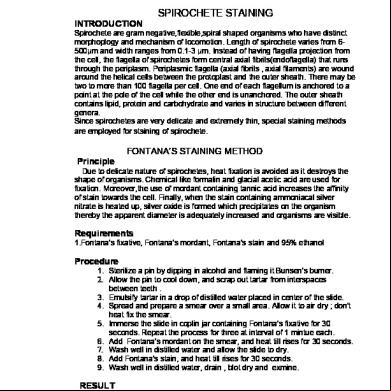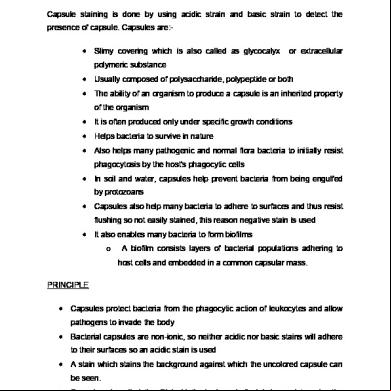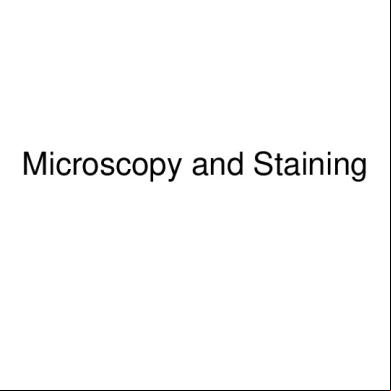Spirochete Staining 3n3n34
This document was ed by and they confirmed that they have the permission to share it. If you are author or own the copyright of this book, please report to us by using this report form. Report 3i3n4
Overview 26281t
& View Spirochete Staining as PDF for free.
More details 6y5l6z
- Words: 622
- Pages: 2
SPIROCHETE STAINING INTRODUCTION Spirochete are gram negative,flexible,spiral shaped organisms who have distinct morphoplogy and mechanism of locomotion. Length of spirochete varies from 6500µm and width ranges from 0.1-3 µm. Instead of having flagella projection from the cell, the flagella of spirochetes form central axial fibrils(endoflagella) that runs through the periplasm. Periplasmic flagella (axial fibrils , axial filaments) are wound around the helical cells between the protoplast and the outer sheath. There may be two to more than 100 flagella per cell. One end of each flagellum is anchored to a point at the pole of the cell while the other end is unanchored. The outer sheath contains lipid, protein and carbohydrate and varies in structure between different genera. Since spirochetes are very delicate and extremely thin, special staining methods are employed for stsining of spirochete.
FONTANA’S STAINING METHOD Principle Due to delicate nature of spirochetes, heat fixation is avoided as it destroys the shape of organisms. Chemical like formalin and glacial acetic acid are used for fixation. Moreover,the use of mordant containing tannic acid increases the affinity of stain towards the cell. Finally, when the stain containing ammoniacal silver nitrate is heated up, silver oxide is formed which precipitates on the organism thereby the apparent diameter is adequately increased and organisms are visible.
Requirements 1.Fontana’s fixative, Fontana’s mordant, Fontana’s stain and 95% ethanol
Procedure 1. Sterilize a pin by dipping in alcohol and flaming it Bunsen’s burner. 2. Allow the pin to cool down, and scrap out tartar from interspaces between teeth . 3. Emulsify tartar in a drop of distilled water placed in center of the slide. 4. Spread and prepare a smear over a small area. Allow it to air dry ; don’t heat fix the smear. 5. Immerse the slide in coplin jar containing Fontana’s fixative for 30 seconds. Repeat the process for three at interval of 1 mintue each. 6. Add Fontana’s mordant on the smear, and heat till rises for 30 seconds. 7. Wash well in distilled water and allow the slide to dry. 8. Add Fontana’s stain, and heat till rises for 30 seconds. 9. Wash well in distilled water, drain , blot dry and exmine.
RESULT Spirochete are stained brownish-black in color against brown background.
BACKER’S STAINING METHOD Principle Mechanism of fixation and mordant is similar to that of Fontana’s method.Here , organisms are stained with Becker’s stain which is made up of basic fuchsin dissolved in alcohol and as the alcohol evaporates, colloidal precipitate formed are deposited on spirochetes. This leads to increase in size of organisms and makes them visible.
Requirements 1.Fontana’s fixative, Fontana’s mordant and Becker’s stain and 95% Ethanol
Procedure 1.Prepare smear in the manner similar to that of Fontana’s technique. 2.Immerse the slide in coplin jar containing Fontana’s fixative for 30 seconds. Repeat the process for three at an interval of 1 minute each. 3. Pour Fontana’s mordant on the smear and allow it to act for 3-5 min. 4.Rinse the slide in running water for 30 seconds. 5.Treat the smear with Becker’s stain for 3-5 min. 6.Rinse in tap water , drain, blot and exmine. Result Spirochetes stained pink in color. OTHER METODS 1.Rue’s method: In this method the apparent thikness of the organism is increased by application of basic dyes in presence of mordant like sodium bicarbonate, which settles onto the cell surface. 2.Levaditi’s method: This method is used to detect spirochetes in tissue. It is modification of Becker’s method in which silver nitrate-pyridine is used instead of basic stain.
EXAMPLE OF SPIROCHETES Treponema denticola :found in oral cavities of animal Treponema macrodenticum :commensal present in gums of teeh. Treponema oralis :found in oral cavities of animals. Treponema palladium :casues syphilis. Spirillum minus : causes rat bite fever.
FONTANA’S STAINING METHOD Principle Due to delicate nature of spirochetes, heat fixation is avoided as it destroys the shape of organisms. Chemical like formalin and glacial acetic acid are used for fixation. Moreover,the use of mordant containing tannic acid increases the affinity of stain towards the cell. Finally, when the stain containing ammoniacal silver nitrate is heated up, silver oxide is formed which precipitates on the organism thereby the apparent diameter is adequately increased and organisms are visible.
Requirements 1.Fontana’s fixative, Fontana’s mordant, Fontana’s stain and 95% ethanol
Procedure 1. Sterilize a pin by dipping in alcohol and flaming it Bunsen’s burner. 2. Allow the pin to cool down, and scrap out tartar from interspaces between teeth . 3. Emulsify tartar in a drop of distilled water placed in center of the slide. 4. Spread and prepare a smear over a small area. Allow it to air dry ; don’t heat fix the smear. 5. Immerse the slide in coplin jar containing Fontana’s fixative for 30 seconds. Repeat the process for three at interval of 1 mintue each. 6. Add Fontana’s mordant on the smear, and heat till rises for 30 seconds. 7. Wash well in distilled water and allow the slide to dry. 8. Add Fontana’s stain, and heat till rises for 30 seconds. 9. Wash well in distilled water, drain , blot dry and exmine.
RESULT Spirochete are stained brownish-black in color against brown background.
BACKER’S STAINING METHOD Principle Mechanism of fixation and mordant is similar to that of Fontana’s method.Here , organisms are stained with Becker’s stain which is made up of basic fuchsin dissolved in alcohol and as the alcohol evaporates, colloidal precipitate formed are deposited on spirochetes. This leads to increase in size of organisms and makes them visible.
Requirements 1.Fontana’s fixative, Fontana’s mordant and Becker’s stain and 95% Ethanol
Procedure 1.Prepare smear in the manner similar to that of Fontana’s technique. 2.Immerse the slide in coplin jar containing Fontana’s fixative for 30 seconds. Repeat the process for three at an interval of 1 minute each. 3. Pour Fontana’s mordant on the smear and allow it to act for 3-5 min. 4.Rinse the slide in running water for 30 seconds. 5.Treat the smear with Becker’s stain for 3-5 min. 6.Rinse in tap water , drain, blot and exmine. Result Spirochetes stained pink in color. OTHER METODS 1.Rue’s method: In this method the apparent thikness of the organism is increased by application of basic dyes in presence of mordant like sodium bicarbonate, which settles onto the cell surface. 2.Levaditi’s method: This method is used to detect spirochetes in tissue. It is modification of Becker’s method in which silver nitrate-pyridine is used instead of basic stain.
EXAMPLE OF SPIROCHETES Treponema denticola :found in oral cavities of animal Treponema macrodenticum :commensal present in gums of teeh. Treponema oralis :found in oral cavities of animals. Treponema palladium :casues syphilis. Spirillum minus : causes rat bite fever.





